A couple years ago I played around with trying to distill M-State material from Dead Sea Salt and Celtic Sea Salt. I’d read the David Hudson lectures a number of times and searched the web for any sources that might have reproduced what David discovered.
One of the sources I came across was the website SubtleEnergies.com. After digging around a bit there, I found the Wet-Method Procedure for isolating M-State from these salts. The procedure can be found here.
I don’t know how many times I read it in order to build the confidence that I could actually perform this ‘science.’ But eventually, I got to that point and gathered the equipment. Figuring that it would be pretty important to follow the directions carefully, I saved a few bucks and acquired a collection of beakers, eye droppers and even a pH meter. The collection turned out to be very similar to this kit found on Amazon:
I think I might have collected a couple more standard beakers and a stand, but that’s pretty close. The pH meter was similar to this:
After reading a bunch of sites and seeing that the directions were all very similar, I figured that the directions that I found were ‘good enough’ for me to get the job done.
Then, I set out to follow the instructions explicitly.
To sum up a couple months worth of testing, I never got to what I felt was M-State material. I remember coming across a statement from David Hudson that the material was like cow sperm (he had a farming background) or a gelatinous concoction. All I came up with was a milky white substance.
After searching around a bit, I found the following information from a David Hudson lecture:
When mixed with water WPG forms a gelatinous mixture. When ingested it has the following affects. “Every cell in your body will be taken back to the state it is supposed to be, when you were a teenager or a child. It perfects the DNA, and closes the light within the body until you literally reach a point where the light body exceeds the physical body.”
It left me a little discouraged. So, I packed up the chemistry set and figured I’d wait until the time was right and keep my eyes open.
Well, it just so turns out that I stumbled across a video on YouTube where it looks like HealingMindN is able to get to the point that I wanted to get to. Here is his video (also shown below). If you’ve been looking for a good video on the wet-method M-State distillation process, this might be it.
Special note: when watching the video, he adds music about 2:23 in. Fortunately, he’s funneled it to the one speaker and his voice is on the other. If you want to hear him without the interference, just turn off the speaker playing the music and turn up the other.
Here are the steps as outlined by the video. I’ve made a few screen shots with the idea of lining up the wet-method with what it is that HealingMindN shows.
Let’s start.
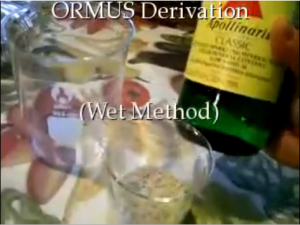
Mineral water. Turns out he’s bought a German import, Apollinaris water. A quick search on the net finds an Amazon source. Search Amazon for product number: 030494881229.
He claims that it contains Magnesium which will be a good catalyst for the process. And, if you look around the web a bit more, you’ll find AquaMaestro which has a great writeup:
Apollinaris is a naturally carbonated mineral water renowned for its health and curative powers. Although not tremendously high in Calcium compared with many other curative brands, Apollinaris it is strong in Potassium, and Sulphate, and gangbusters in Magnesium and Bicarbonate at 130 milligrams and 1810 milligrams per liter respectively. What you might not like is the Sodium – also extremely high at 410 milligrams (almost a half a gram) per liter. And, it must be noted that we have not ascertained the all-important Nitrate level. …
So, that part holds up. In any case, he claims that 2 cups distilled water plus 1 teaspoon of Epsom salts may be substituted if the water is not found (video 00.15).
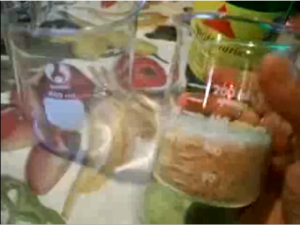
Half cup Celtic Sea Salt. That stuff looks like this (above). Search Amazon for product number: B000SWVPV8.
You can probably find that in your local health food store. The CelticSeaSalt website has a write-up about it that reads:
Celtic Sea Salt® Brand Light Grey Celtic® is totally unprocessed, kosher and hand harvested. It is dried by the sun and the wind, retaining the ocean’s moisture and locking in a vast array of vital trace elements. Celtic Sea Salt® Light Grey Celtic® is a coarse, moist salt that gets a light grey hue from the pure clay sole it is harvested from. There is no comparison, in taste or in health effects, between mineral-rich Celtic Sea Salts® and chemically-treated iodized salts. …
And, again, HealingMindN suggests that other sea salts may be substituted such as Lima Atlantic or Dead Sea Salt.
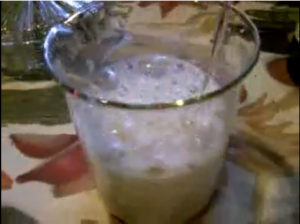
I believe he’s saying that he’s adding 450 milliliters to the beaker too which he adds the salt. After stirring for a moment, it sounds like he says he’s going to let it sit overnight.
Great. That is a step that I do not remember from the Wet-Method procedure written up at SubtleEnergies. Yet, maybe it doesn’t have to sit overnight.
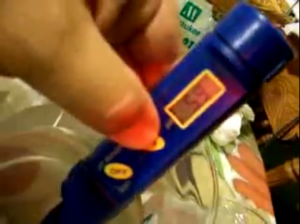
Looks like the starting pH of the salt water is 5.9.

And now for his setup – food grade lye water. Looks like he’s using Tropics Lye Water. Turns out that Amazon also shows this product.
He claims it’s about 12.7 pH. Anyone should be able to validate that pretty easily. It looks like at second 2:10 in the video, he’s got 140 milliliters of Lye Water that he’ll be using.
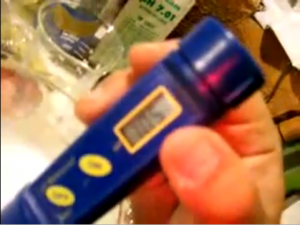
Looks like he continues to add the lye solution until the Sea Water hits 10.5. He points out that it is point 1 to go from stop. Thus, he’s looking for 10.6 as the stopping point for this pH swing.
(Editors note: The lye mixture is an 8:1 mixture. Add 8 parts water to a beaker and then slowly, in a vented area, add the other 1 part lye crystals while stirring careful not to overheat. This information can be found by digging around a bit on the SubtleEnergies site or visiting the OrmusBook. There, I quote from the FAQ section:
…For the processes detailed in the book, a 1:8 strength works very, very well. That is ½ cup of lye (NaOH) crystals mixed as described in the book into 1 quart of distilled water. This would be about 125 grams per liter of water in the metric system.
Yet you don’t need that much for these small volumes. A 1:8 mixture would be 25 millileters lye to 200 milliliters distilled water. )
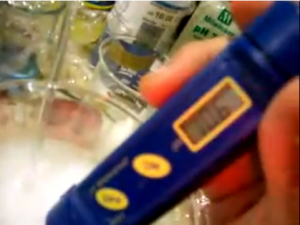
At 3:17 in the video, The participate has formed, it’s mainly Magnesium Hydroxide Lye … and a little M-State. He is now at pH 10.6.
Overall, he’s added about 140 milliliters of lye just like he did last time and he’s going to let it sit overnight. So that it settles.
He makes a comment to not use anything but glass so as to not disrupt the M-State material.
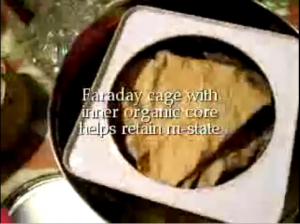
Here, he shows his Faraday cage that he uses to place the M-State material in overnight. His faraday cage is two cookie containers where the center one is lined with steel wool where there is a brown paper bag inside of that. His participate container has cellophane with a rubber band holding it on.
It might be work investigating this a little more. If M-State is sensitive to electromagnetic energy, shielding it might be a good idea. Yet, I’m not sure how well his box is working, for one of the key elements of a Faraday cage is grounding. Yet, let’s continue.

He shows about 300 milliliters of precipitate and the covering liquid has a pH of about 10.4.
He comments that he’s going to wash the precipitate three times.
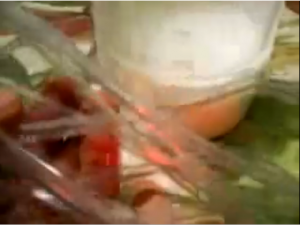
Here he shows the plastic tubing that he’s going to use to remove the liquid on top of the precipitate.
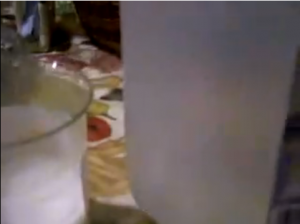
Here we can almost see the brand of distilled water that he’s going to use to water the precipitate. He fills the container up to about 600 milliliters again so that he can let it settle again overnight.
At this point I have to assume that he goes through the washing process all three times before coming back to the video. Thus, at this point, he’s just about doubled the water content in his beaker three times and removed the substrate covering the precipitate as he outlined. If he lets it settle overnight each time, a few days have passed.
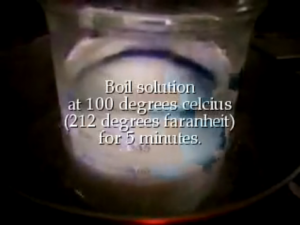
He then jumps straight into the boiling process. We can see from his text that he boils for 5 minutes.

Here he shows the precipitate after boiling and he’s going to take it to pH 12. He stated that last time it took nearly 50 milliliters of Lye water to perform that task.
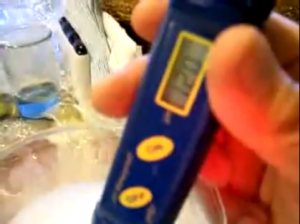
Here he shows that he’s raised the pH to 12.0. At this point, the M-State will be re-dissolved in solution. Shortly after showing the pH, he comments that he should have drained off more substrate (the clear liquid on top) for he recognizes that he has more volume than what he was expecting.
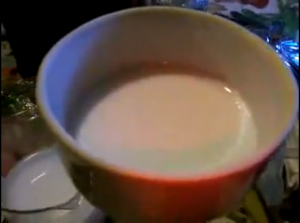
Here we see the filter that he’s going to use to remove the precipitate leaving just the clear liquid holding the M-State material.
At this point, I wish I knew what that filter was. I’ve searched around on some different chemistry supply websites, but when you don’t know what you’re looking for, it makes things a little harder to find. Hopefully, I’ll find a picture that matches what he’s using.
(Author’s note: Ask and you shall receive. As it turns out, I now have a better idea what this filter is. Turns out OnlineScienceMall has a number of different sizes to choose from. They call them Filtration Assemblies. Follow the link and the picture will really sum it up.)
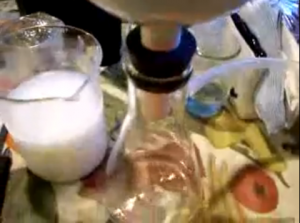
Here is a good picture showing his flask with the rubber stopper holding the funnel filter. What gathers in the flask (the filtrate) is what he’s looking for.

Here he shows the pH of the filtrate. He comments that it’s gone down a little to 11.8.
At this point, he mentions something like “from here on out it’s a feeling out process as the ‘coopers pairs’ start forming in solution they start congealing just like making gelatin.”
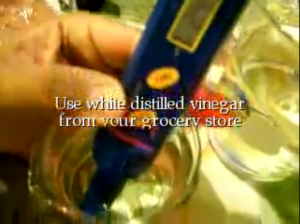
Now he goes to bring the solution down to 10.78 pH. He uses acetic acid. The form of the acid is white distilled vinegar that you’d find in the grocery store. During this process, the ‘coopers pairs’ should start forming.
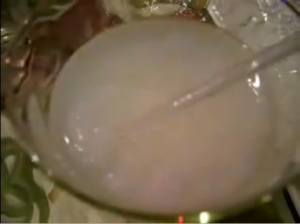
Here he shows nice big globules of M-State ‘Jello.’
After watching this video, it seems pretty simple. I just might have to give it another try.
The only question that I have is about the filtering process. Looks like HealingMindN is using a filter flask, but I can’t find the actual filter online. I’ll have to keep looking and see what I can find. If I can come up with that final setup, then I’ll give it another try. (See comment above for a link to filtration assembles.)
As a point of reference, I’ve included the process form SubtleEnergies.com below. The steps are nearly identical. The only real difference comes at the end when HealingMindN mentions that it’s a feeling out process from here on out.
Wet Method Procedure.
If you are using dried sea minerals, mix 1/2 cup of dry material with 2 cups of distilled water. This makes sea water. Now proceed as described below:
1. First, you might want to pour the sea water through a coffee filter to remove any scum.
2. If the starting material does not contain magnesium hydroxide (sea water does contain magnesium hydroxide), add some, or add a teaspoon of Epsom salts per gallon of water.
3. Pour the sea water into a stainless steel pot. Slowly, drop-by-drop, add the lye solution WHILE STIRRING. Every ten drops or so, test the pH. You might want to take at least 3 to 5 samples from different regions of the liquid. If you are using pH paper, the goal is to bring the pH up to 9.5, then stop to be on the safe side. If you are using a pH meter, stop just before you get to pH 10.78.
A white precipitate which includes m-state elements will form.
CAUTION: You must proceed slowly and patiently so that you do not exceed pH 10.78 with a meter or pH 9.5 with pH paper. If you go higher than pH 10.78, you might get a “Gilcrest precipitate” of toxic heavy metals. It is alleged that the Dead Sea salt water does not produce any Gilcrest precipitate. This has not been proven and should not be assumed.
4. Once you are at the correct pH, stop.
5. Pour the solution into a clean glass jar or test tube.
6. The white precipitate (slurry) slowly settles on the bottom of the jar. Let the slurry settle overnight. If metals or other toxins have been ruled out by prior testing of your starting material, the slurry is probably mostly calcium hydroxide, Mg(OH)2, lye, and a small amount of m-state.
You can speed this settling process with a centrifuge, which forces the precipitate to settle rapidly. Inexpensive second-hand centrifuges may be found at American Science and Surplus, http://www.sciplus.com.
7. Using a large syringe (or siphon), remove the liquid above the slurry.
8. Add distilled water to the precipitate (filling the jar), stir thoroughly, and let it settle again for at least 4 to 5 hours, preferably overnight.
9. Repeat steps 7 and 8 at least three times to thoroughly wash the precipitate. This should remove almost all of the lye. The remaining lye can be neutralized with HCl or distilled white vinegar as well. Washing three times is intended to reduce the dissolved “impurities” (like salt, for example) by 87.5%. Four washes would provide a 93.75% reduction, five washes a 96.875% reduction, and so on.
At this point, the precipitate is likely to contain some m-state, milk of magnesia Mg(OH)2, calcium, and perhaps some impurities.
Pour the precipitate and water into a stainless steel pot on a stove burner. A gas burner is preferred over electric because any magnetic fields from the electric burner may drive off some of the m-state material. Cover the pot with a lid to contain the m-state, and boil the solution for 5 minutes to sterilize it. Be careful not to spill the hot solution! Let it cool back to room temperature and recheck the pH to make sure it hasn’t exceeded pH 9.
DISCUSSION: WHEN TO BOIL THE SOLUTION
In this document, we suggested that you not boil the solution until you have made the washed precipitate. However, boiling can be done earlier in the procedure with certain advantages. Here are four times that boiling could be done, with a discussion of the pros and cons of each:
1. Boil before adding lye solution.
PROS: Faster reaction, faster precipitation. CONS: You may spill the hot lye solution. You may inhale fumes.
2. Boil while adding lye solution.
PROS: Faster reaction, faster precipitation. CONS: You may spill the hot lye solution. You may inhale fumes. Danger of lye spurting out of pot. Not recommended.
3. Boil and cool after adding lye solution.
PROS: No danger of inhaling fumes. Little danger of spilling hot lye solution. CONS: Slower reaction, slower precipitation.
4. Boil the washed precipitate (recommended).
PROS: No danger of inhaling fumes. No danger of spilling hot lye solution. pH is unlikely to change after boiling because the reaction has already taken place. CONS: Slower reaction, slower precipitation. If safety is the main issue, this seems to be the best method.
Caution: If you boil the solution on an electric burner, the magnetic field in the burner may “blow off” some of the m-state materials, resulting in a small yield. This can be minimized by adding a source of sodium (such as sodium hydroxide or salt) to the solution before boiling.
Since sea water contains sodium in salt, none of the boiling methods will be a problem with sea water. However, if you are starting with low-sodium fresh water, add a sodium source (such as table salt or lye solution) before boiling.
Once the precipitate and water have been sterilized, the next step is required to concentrate the m-state.
HOW TO PURIFY YOUR PRECIPITATE
The precipitate made from sea water contains milk of magnesia (Mg(OH)2), which precipitates approximately around the same pH range that m-state does. Here are four methods to separate Mg(OH) 2 from m-state:
METHOD 1.
1. Suppose you just made a precipitate by adding lye solution to sea water. The precipitate is m-state mixed with Mg(OH) 2.
2. Use a syringe to remove the liquid over the precipitate, and discard the liquid. This leaves only the m-state/Mg(OH)2 precipitate.
3. To the wet precipitate, add hydrochloric acid (HCl) until you reduce the pH to 1.0 – 3.5. You can use muriatic acid (31% HCl) from a hardware store, but lab-grade HCl is less likely to be contaminated. A safe alternative to HCl is distilled white vinegar.
4. The white colloidal precipitate should dissolve, leaving a clear solution.
5. Add lye solution VERY SLOWLY drop-by-drop to bring the pH back up to 8.5 – 8.7. The precipitate that forms should be m-state mostly free of Mg(OH)2 (because m-state precipitates in this pH range, and Mg(OH)2 does not precipitate until pH 9.)
Note that your total yield may be diminished because you are not going past pH 8.7.
6. Remove the liquid above the precipitate, and wash the precipitate. It should be mostly m-state.
METHOD 2
This procedure removes the Mg(OH)2 by dissolving it below pH 9. First get some HCl (or muriatic acid) and coffee filters. A safer alternative to HCl is distilled white vinegar.
1. Dry the precipitate in a dark oven at about 275 degrees F for one or two hours. This forms a dry powder.
2. Take the dry powder and pulverize out any clumps.
3. In a glass container, cover the powder with some distilled water. For example, one liter of water for one cup of powder.
4. Add HCl or distilled white vinegar drop-by-drop to bring the pH to 5 or 6.
5. Shake the bottle and let it sit overnight. The dried m-state should not dissolve at that pH, but the Mg(OH)2 should dissolve.
6. The next day, after all the Mg(OH)2 has dissolved, pour everything into filter paper.
7. Wash the powder collected in the filter paper several times with distilled water to remove any residual traces of HCl or vinegar.
8. The washed powder may be oven-dried again at about 275 degrees F, and you should have m-state powder free of Mg(OH)2.
METHOD 3
1. Dry the original precipitate at about 200 degrees F.
2. Mix the resulting powder with distilled white vinegar or 30% HCl. Everything which does not dissolve in m-state. This will be quite a small amount if you start with sea water. (If you mix pure HCl with distilled water, remember: ADD ACID TO WATER, NEVER ADD WATER TO ACID).
3. Measure the amount of HCl/m-state solution (or vinegar/m-state solution).
4. Add distilled water to the HCl/m-state solution. Add an amount of water that is at least ten times the amount of HCl/m-state solution. (You may substitute distilled white vinegar for HCl).
5. Filter the solution through 5 layers of coffee filters.
6. Wash the powder at least three times in a large amount of distilled water.
METHOD 4
1. Starting with clean wet precipitate, add lye to bring the pH up to 12. The m-state precipitate will dissolve, but magnesium hydroxide and the Gilcrest precipitate will not.
2. Filter out the precipitate.
3. To the remaining liquid containing only m-state, add HCl or distilled white vinegar drop-by-drop until the pH reaches 8.5.
4. Add lye solution drop-by-drop to bring the pH back up to 10.78. The resulting precipitate should be only m-state.
5. Wash the precipitate as described earlier.
6. To be safe, check the pH of the precipitate slurry. It should be 9 or less before ingesting.

Hi Brenda,
You’re the first question about this in a long time. Note that I copied these methods from SubtleEnergies.com and it looks like their website is still up and running.
My understanding of the instructions is – yep. Washing the precipitate thins out/removes what’s in solution. If I understand this correctly, the precipitate doesn’t have a charge so it can’t be carried by water. Thus, it falls out. Everything else is still in solution, thus whatever is left can be thinned and washed away.
Second question is a really good one! In my experience, as you add the acid back in, the H will dissolve the precipitate and it goes back into solution. Or, it becomes clear again like water. Now, should it? Logically, it makes sense if what you have is common mineral solutions. If you have M-state, I don’t know. I wasn’t able to get to something that wasn’t logically explainable.
Glad you stopped by. If you’re able to find something that can’t be logically explained away, I’d love to hear about it.
Dave
Hi Dave
Forgive me for taking you back if anyone else asked it already.
The video stops at the jelly look ORMUS at ph 10.78. It sounded like this is it. He says I got my Ormus.
1. I read in your method 4 step 5 that I must wash the precipitate again. Is that right?
2. Is the jello look going to dissolve again or should it remain jello until it reaches ph 9 or less?
Will it reach PH 9 or less just by the “wash step” 5?
Thanking you in advance